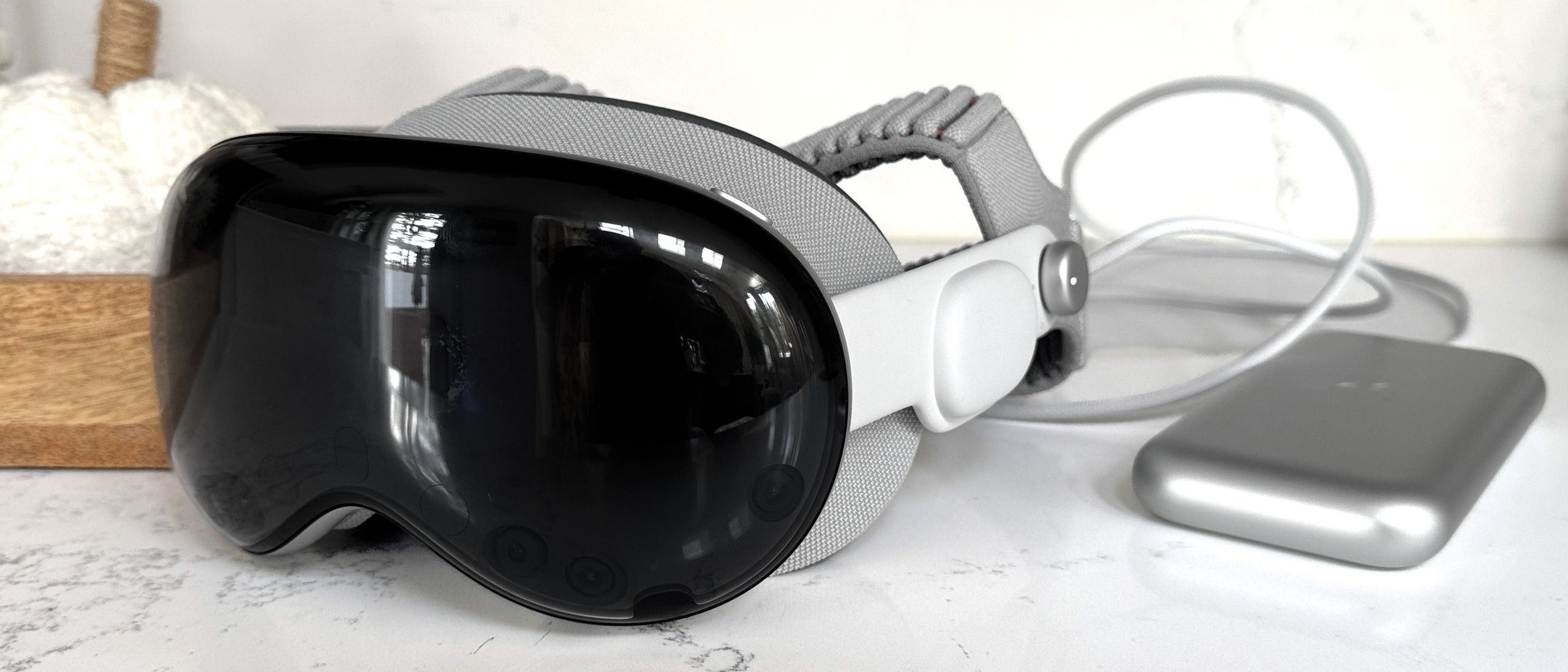Copyright tomsguide

It’s been almost two years since the original Apple Vision Pro launched. So I’m kind of shocked by how little new the Vision Pro M5 brings to the table — or more aptly, your face. The Vision Pro 2025 (still a gulp-inducing $3,499) packs a powerful M5 chip for improved performance and visuals, and it also enables longer battery life. Plus, Apple has partially addressed the comfort issue by including a comfier Dual Knit Band. That’s it for the newness. The design is nearly identical to the original model but somehow heavier. You still need to schlep around a battery pack. And high-profile apps like Netflix and YouTube are still missing. There’s no multi-modal AI to speak of either as Apple continues work on the next Siri. But the Vision Pro still frequently amazed me. It feels like the future when you pin the photos widget to your space and peer through it like a window. I got a thrill out of an immersive movie that put me inside Yankee Stadium. And it’s pretty wild to see other Personas in a virtual meeting space as you pass around a 3D model. So where does that leave this spatial computing device? Here’s the pros and cons in my Vision Pro M5 review. Vision Pro M5 Cheat Sheet Who is it for? People who want to experience spatial computing and are willing to pay a premium What does it cost? from $3,499 What I like: Faster M5 chip with better visuals, longer battery life and comfier strap What I don’t like: It’s even heavier, just as pricey and the Vision Pro is still missing important apps like Netflix and YouTube. And there’s no Visual Intelligence or advanced Siri. Vision Pro M5 design: Comfier and heavier?! The good news is that the Vision Pro M5 is much more comfortable to wear than the original. The bad news is that it’s even heavier. The new Dual Knit band takes a best-of-both-worlds approach, combining the soft mesh fabric of the Solo Knit Band with the stability of the Dual Loop Band, so there’s a strap that goes behind and across the top of your head. I adjusted the Dual Knit band via Apple’s ingenious dial. You just rotate to tighten the lower strap and then pop it out and twist to adjust the top band. This new band is critical, because there’s more weight to support. The Apple Vision Pro weighs 26.4-28.2 ounces (750-800 grams, depending on the light seal), compared to 21.2-22.9 ounces (600-650 grams) for the previous model. That feels like a step backwards. Meanwhile, the Samsung Galaxy XR is tipped to weigh just 19.2 ounces (545 grams). And it doesn’t require a second strap going across the top of your head. Maybe I’m being a bit vain, but I don’t like that the Vision Pro is guaranteed to mess up your hair. I will say that the Vision Pro is comfier to wear for longer sessions. I felt less pressure by eyes after 30 minutes and no neck strain, which is an improvement. The overall interface is just as intuitive as before, as the Vision Pro smoothly and accurately tracks your eyes and fingers, whether you’re opening an app with a pinch, pinching and scrolling or launching Control Center by flipping your hand around. Vision Pro M5 Chip: Slightly better performance, longer battery life The new M5 chip inside the Vision Pro is designed to deliver sharper details and smoother performance. You get 10% more pixels and up to 120Hz refresh rates. I compared the Vision Pro M5 vs the original Vision Pro M2 side by side, and the new model loaded Fruit Ninja a few seconds faster. The graphics did look crisper in my sunroom, but it wasn’t a huge difference. The live pass-through view through the Vision Pro M5 also exhibits less motion blur. So when you’re looking around it feels more like real life than a broadcast of your surroundings. The biggest benefit of the M5 chip inside the Vision Pro is actually the extra endurance. It’s rated for 2.5 hours of “general use” and 3 hours of video playback, compared to 2 hours/2.5 hours for the previous model. After using the Vision Pro for an hour and a half I was down to 55%, which is pretty decent. If you’re sitting down and near an outlet, you can keep the battery charged as you work and play, but it’s not fun feeling like you’re tethered. Vision Pro M5 Apps and Experiences You might be wondering if there’s a killer app for the Vision Pro yet. I don’t think so, though there’s plenty of options to choose from now in the App Store. The most compelling apps are still from Apple, starting with Photos. With the new Spatial Scenes option, you can turn any 2D photo into a 3D one. I felt like I was back in the city of Bath in the UK while I viewed the Pulteney Bridge with some geraniums in the foreground. It was also very cool to see my lab mix puppy as if she was right in front of me. The Apple TV app has a lot more Immersive videos now, and I was blown away by ‘Elevated: Hawaii.’ It felt like I was flying above a volcano spewing lava and smoke. And the Yankee Stadium video took me to the Bronx and into the stands from multiple angles for a game versus the Dodgers. Watching 3D movies on the Vision Pro M5 is also compelling. I used the theater environment to watch ‘Superman,’ and it was even more exhilarating seeing the Man of Steel try to fight off Ultraman and The Engineer, complete with Spatial Audio than it was at my local multiplex. There’s some pretty fun games to play, including Thrasher. It was pretty amusing using my fingers to control a dragon and lead it through rings. And I got a good workout playing Beat Punch, in which you punch colored squares to the beat and dodge obstacles. However, Ping Pong Club was a letdown. Using my hand as a paddle felt less than satisfying, especially since I missed a lot of balls I would usually hit in real life. You can upgrade to Sony’s PSVR 2 controllers, but they cost a whopping $249. Unfortunately, the Vision Pro is still missing a lot of big-name third-party apps. There’s no official Netflix or YouTube app (you have to go through Safari). And you don’t get any Google app for that matter (Gmail, Google Maps) or Meta apps like Instagram. Vision Pro M5 Personas: Better but still creepy Apple touts that Personas through the Vision Pro now offer more detail and an overall more realistic depiction of you, which can be used in FaceTime calls. But I wasn't that impressed with the results. I had a FaceTime call with my daughter and she said my Persona looked “older and uglier” than the real me. And I concur. And you can’t do much to tweak your Persona after the fact, although you can change the skin tone and Portrait effect, as well as add eyewear. At least the Personas look less ghostly, now, as the Vision Pro does a better job of showing your profile when you turn your head. Mac Virtual Display: Still magical (and improved) One of the most underrated features of the Vision Pro is the Mac Virtual. You just look at your open MacBook, click on the virtual Connect button floating above the screen and — boom — you get a huge 5K monitor right in front of you. And you can choose from wide and ultra-wide options to fit more apps on the virtual display. Plus, with the 120Hz refresh rate and 10% extra pixels, the experience feels much more natural than before. I sometimes experienced a bit of lag when typing, but overall Mac Virtual Display is very well executed and something the Galaxy XR can’t emulate. Widgets: A sneak peak of Apple Glasses? One of the most fascinating features of visionOS 26 is the addition of widgets. You can place them anywhere in the room and they’ll remain persistent. Even better: when you snap the widget to a surface it feels like it’s part of the wall. For example, with the Photos widget I could walk up to it and see my favorite panorama pics and look to the left and right as if I were peering out a window. However, it took a bit longer than I’d like for the photo to load. It’s also nifty to be able to place the Apple Music on the wall and have it look like a concert poster. In my case I chose Coldplay. There’s third-party widgets available, too, such as Fantastical Calendar and Slack. I know AR Apple Glasses are probably still years away, but I could see this being a big part of that experience. What’s missing from the Vision Pro M5: Where’s the powerful AI? While Gemini Live is a key part of the Galaxy XR headset and Android XR, Apple is playing from behind with Apple Intelligence through the Vision Pro. Yes, the Vision Pro supports Apple Intelligence through features like Image Playground and Writing Tools, but it’s a huge miss that Visual Intelligence isn’t yet supported. That means you can’t simply look up info on whatever you happen to be looking at. With the Galaxy XR, Gemini Live can analyze what you’re seeing, answer questions and generally be your copilot on mixed reality. For example, in Google Maps you can ask Gemini to take you to a specific location or ask about nearby restaurants. Apple has some catching up to do, and the new and improved Siri isn’t expected until 2026. Vision Pro M5 review: Verdict When I reviewed the original Vision Pro, I called it a “revolution in progress.” Well, now I feel like that revolution has stalled. Yes, the Vision Pro M5 offers a faster chip and a comfier strap, but I expected much more hardware and software innovation from Apple for what’s supposed to be a category-defining product. I would have liked to see Apple attempt a lighter design and/or a lower price. There are rumors that Apple was working on a lighter, cheaper and less powerful spatial computing headset, but its fate seems up in the air given that the industry seems to be marching towards smart glasses like the Meta Ray-Ban Display. As the competition ramps up from Samsung’s Galaxy XR with Gemini Live inside, the lack of a new and improved Siri and especially Visual Intelligence are pretty glaring omissions from the new Vision Pro. There are things I really like about the Vision Pro M5, but right now a refresh simply doesn’t cut it.



